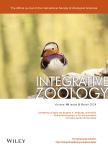A new chelonibiid from the Miocene of Zanzibar (Eastern Africa) sheds light on the evolution of shell architecture in turtle and whale barnacles (Cirripedia: Coronuloidea)
作者机构:Dipartimento di Scienze della TerraUniversitàdi PisaPisaItaly Museo di Storia NaturaleUniversitàdi PisaCalciItaly MBRDScripps Institution of OceanographyLa JollaCaliforniaUSA Dipartimento di Scienze dell’Ambiente e della TerraUniversitàdegli Studi di Milano-BicoccaMilanoItaly
出 版 物:《Integrative Zoology》 (整合动物学(英文版))
年 卷 期:2022年第17卷第1期
页 面:24-43页
核心收录:
学科分类:0710[理学-生物学] 07[理学] 0905[农学-畜牧学] 0906[农学-兽医学] 071002[理学-动物学]
基 金:Cecilia Vianello Derek Ohland Gianna Innocenti Gianni Insacco MCSNC MSNV MZUF NHMUK SAM-PK Systematics Research Fund Systematics Association, SA Linnean Society of London RMIT University, RMIT Academia Sinica Chinese Academy of Sciences, CAS
主 题:†Chelonibia zanzibarensis sp.nov. epibiosis evolution functional morphology systematics
摘 要:The fossil history of turtle and whale barnacles(Coronuloidea:Chelonibiidae,Platylepadidae,Coronulidae and†Emersoniidae)is fragmentary and has only been investigated in part.Morphological inferences and molecular phylogenetic analyses on extant specimens suggest that the roots of whale barnacles(Coronulidae)are to be found among the chelonibiid turtle barnacles,but the hard-part modifications that enabled early coronuloids to attach to the cetacean skin are still largely to be perceived.Here,we reappraise a fossil chelonibiid specimen from the Miocene of insular Tanzania that was previously referred to the living species Chelonibia caretta.This largely forgotten specimen is here described as the holotype of the new species†Chelonibia zanzibarensis.While similar to C.caretta,†C.zanzibarensis exhibits obvious external longitudinal parietal canals occurring in-between external longitudinal parietal septa that abut outwards to form T-shaped flanges,a character so far regarded as proper of the seemingly more derived Coronulidae and Platylepadidae.Along with these features,the presence of a substrate imprint on the shell exterior indicates that†C.zanzibarensis grasped its host’s integument in much the same way as coronulids and platylepadids,albeit without the development of macroscopic parietal buttresses and bolsters.Thin section analyses of the inner parietal architecture of some extant and extinct coronuloids conclusively demonstrate that vestiges of comparable external parietal microstructures are present in some living members of Chelonibiidae.This observation strengthens the unity of Coronuloidea while significantly contributing to our understanding of the evolution of the coronuloid shell structure in adapting to a diverse spectrum of hosts.



